Birdsfoot Trefoil (Lotus corniculatus) Identification & Use
Birdsfoot trefoil is an amazingly scented summer wildflower. Currently used for forage and erosion control, it also feeds pollinators and has a history of medicinal use. We'll help you get to know this roadside beauty.
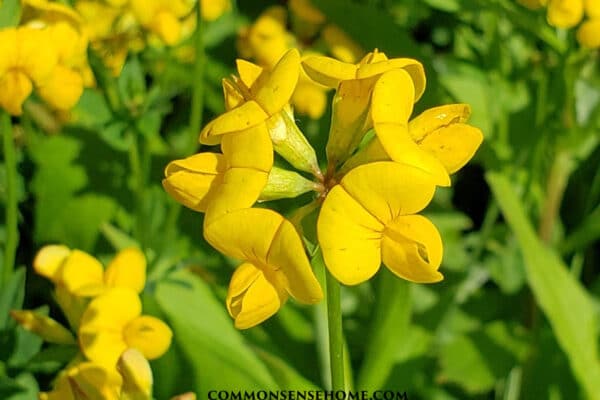
Range and Identification of Birdsfoot Trefoil
Lotus corniculatus is native to Eurasia. Introduced from Europe as a forage crop, birds-foot trefoil spread throughout most of North America. It prefers dry, sunny locations, and thrives in poor soil with low nitrogen.
It's a perennial herbaceous plant in the pea family, like alfalfa. Like other members of this family, it forms nitrogen setting root nodules. These nodules help add nitrogen to the soil and make it available for other plants.
Roots and Stems
The plants have a deep tap root and side roots (rhizomes) along the surface. These tap roots make it drought resistant. Stems spread horizontally, forming dense mats of vegetation that may crowd out native plants.
New plants can sprout from the rhizomes and where stem nodes touch the ground. The plants also spread from seed. Plant height ranges from 6 to 24 inches tall at maturity, depending on variety.
Leaves
The compound leaves have five parts, a 3-part upper leaflet group with two lower leaflets at the base. The group of three oval trifoliate top leaves is the “tre” in “trefoil”. Leaves alternate up the stem.

Flowers and Seeds
The plants bloom from late spring into fall. Flowers are bright yellow at the beginning of their bloom time, becoming more orange as they age. They resemble pea blossoms about 1/2 inch across, and cluster in masses at the top of stems.
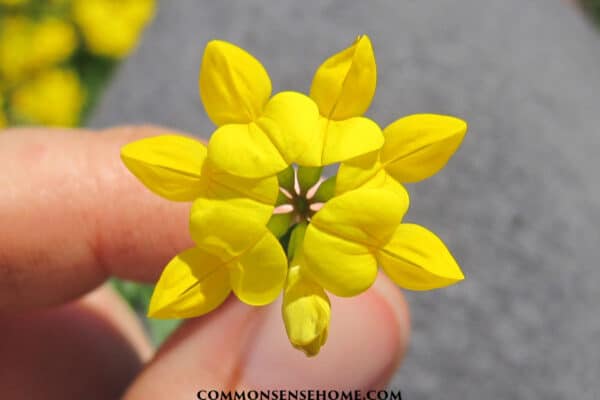
The one inch long seed pods look like a bird's foot. (The names “granny's toenails” and Devil's fingers” also refer to the seed pods.) Each slender pea-like pod contains 10 to 50 small black or brown seeds.
Like many wild plants, seeds can remain viable in the soil for years. Burning doesn't work well for controlling the plant, as is may assist with germination.
Birdsfoot Trefoil Uses
Forage, erosion control, pollinator habitat, medicine, fabric dye, perfumery – this humble plant has a long history of use.
Forage and Hay
Unlike alfalfa and clover, birdsfoot trefoil does not cause bloating in cattle. As a legume, it fixes nitrogen in the soil, which can improve the growth of nearby grass. It's also tolerant of drought and poor soil. This combination makes it a valuable forage plant.
Missouri Extension notes: “A combination of trefoil and bluegrass or other cool-season grasses will produce three times as much feed as unimproved grass. Even heavily fertilized grass will produce one-third less beef per acre than a trefoil-bluegrass combination.”
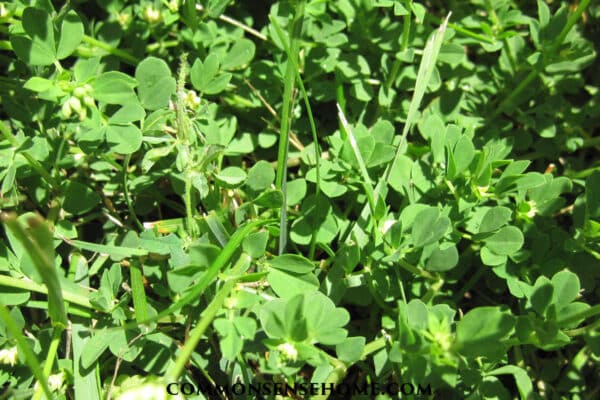
Milk from cows fed on trefoil hay contains more vitamins A and E than those fed on alfalfa (Handbook of Legumes of World Economic Importance, Plenum Press, NY, James A. Duke, 1981). (source)
The condensed tannins in birdsfoot trefoil suppress internal parasites in cattle, and help the animals digest grass better. Though it can be used for hay, it works better as a forage crop. Note that the plants may accumulate prussic acid during drought conditions. Take this into consideration when using the plants as forage.
Erosion Control
Lotus corniculatus spreads readily in disturbed soils. This makes it useful for erosion control along roadsides, because it covers the area but stays low to the ground.
Included in wildflower mixes in Europe, it may become an invasive species in some settings. It's best to avoid avoid adding this plant to the mix in natural areas or prairie restoration projects.
Wildlife Use
Bumblebees and other bees love the pollen and nectar from the bright yellow flowers of birdsfoot trefoil. The plant produces abundant, concentrated nectar, and is a valuable honey plant. European skipper and sulfur butterflies also use it as a nectar source. Sulfur caterpillars use the foliage as a food source.
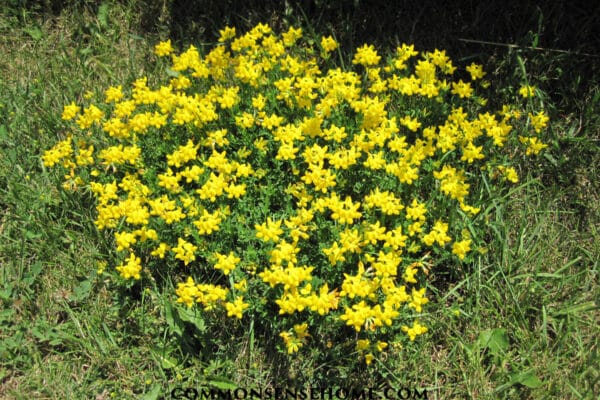
Doves, pheasants, and rodents feed on the seeds; while deer, rabbits, and other herbivores browse on the foliage.
Birdsfoot trefoil is a good choice for food plots for deer, for the same reason it works well for livestock. (One of the common names of the plant is “birdfoot deervetch”.) It tolerates poor soil and grazing, and improves the health of grasses in the mix.
Medicinal Use
Traditionally, Lotus corniculatus has a history of medicinal use as a painkiller, antihemoroidal, diuretic and sedative. It's commonly dried and prepared as a tincture, decoction (tea), pill, or powder.
Note that the plants contain cyanogenic glycosides, which are natural plant toxins. These cyanogenic glycosides can break down into hydrogen cyanide during chopping or mastication. Heat breaks down the hydrogen cyanide, and our bodies have an enzyme that breaks it down. That said, the plants should still be used in moderation.
A recent study in Turkey found that an alcohol extract of birdsfoot trefoil showed potential as an antidepressant. Another study found that the essential oil from these plants improved both acute and chronic pain. Historically, it has been used externally as an anti-inflammatory compress.
Do not use internally if you are nursing, pregnant, have low blood pressure, or on medications. May cause drowsiness.
Fabric Dye and Perfume
Another historical use of Lotus corniculatus is as a dye for natural fabrics, such as wool. The flowers provide an orange-yellow color. Here's an example of the dyeing process and dye plants.
When the flowers are at their peak in our area, the fragrance is amazing. The summer heat brings out the full scent of the blooms. I'll often roll down my windows where the roadside blossoms are thickest just to enjoy the fragrance.
Though less common in the United States, Lotus corniculatus flower extract is listed n the European cosmetic ingredient database. I found a body serum from Switzerland that includes it, and promises noteworthy results (with a sizeable price tag). It might be a fun experiment to make some with a home distillation kit.

Other Names
Birds-Foot Trefoil is also known as broadleaf birdsfoot trefoil, Birdfoot Deervetch, bacon and eggs, Dutchman’s clogs, lady’s slippers, granny’s toenails, and Devil’s fingers.
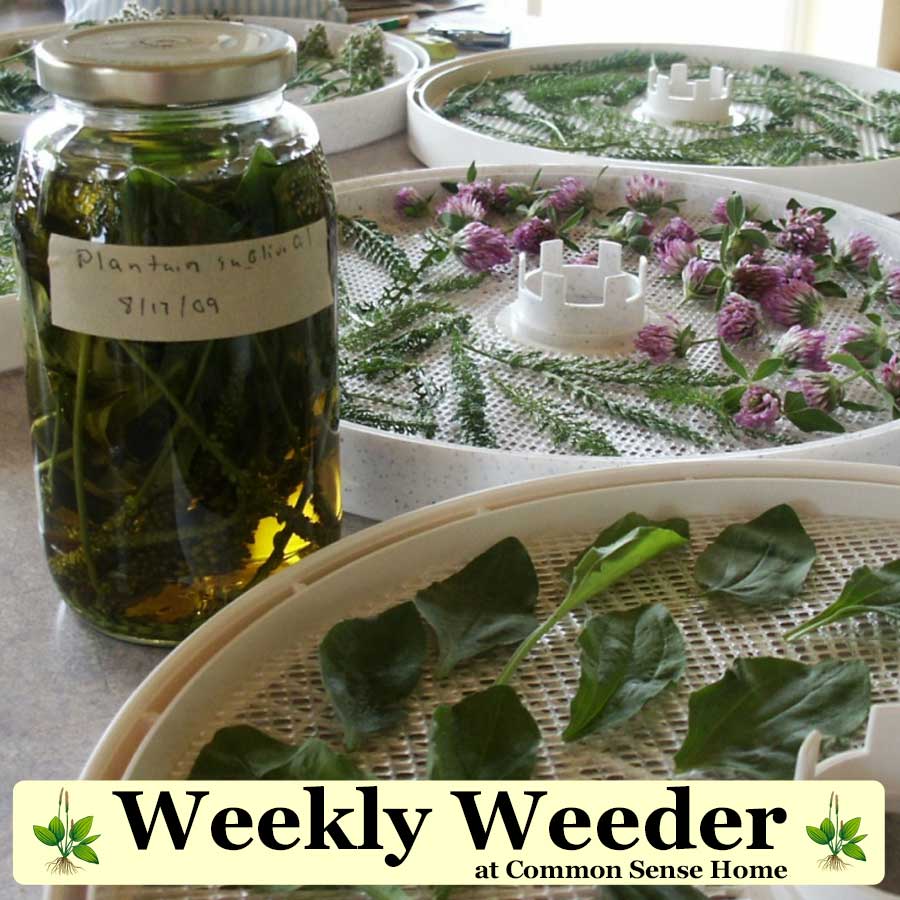
More Information about Wild Plants
This article is part of the Weekly Weeder series, where share how to use common wild plants. You can view the entire series on the Herbs and Wildcrafting page.
Articles include:
- My Favorite Wildcrafting Resources
- Quackgrass – Identification, Control, and Uses
- Grandma Called it Medicine Leaf

This article is written by Laurie Neverman. Laurie was raised on a small dairy farm in northwest Wisconsin, where she gathered wildflowers from the woods and pastures. She and her family now live in northeast Wisconsin, where they combine intentional plantings and semi-wild areas. Every season is a new opportunity to learn more about working with wild plants.
Originally posted in 2012, last updated in 2024.


Thanks for including this one in the big WR! This plant has been drifting into our property from our roadside and driveway. Since it looked like a legume, I figured it was a nitrogen fixer and possible livestock feed, and have given it a pass. It is pretty, my chickens won’t touch it, guess I won’t be letting it into the garden or my compost pile. We do have a little flock of elk colonizing our neighborhood, so maybe some special guests will drop by sometime!
ohh Noooooo. smoothered everything. I am still digging it up 2 years later. beware
Thanks for featuring my post and for the info on trefoil. I had no idea about any of that!
You’re welcome. Thank for joining in the hop.
Thanks for the blog. How do you prepare this weed to use medicially?
Because of the potential risk involved with this one, I’d advise you to try and seek out a more detailed herbal if you’re interested in using it for that purpose. I have not come across detailed use instructions online or in the herbals I have, probably because of that risk. Most herbs are commonly used to make teas or infusion for treatment. Common Mullein is used in many of the same applications, without the toxicity risks – https://commonsensehome.com/weekly-weeder-13-common-mullein/
Glycosides are very sensitive to heat. Heating and drying destroy the compounds rendering them inert. Which is why we can bake.with bitter almonds and how the native Americans used to consume choke cherries with the pits smashed in them
Thanks for hosting Laurie! I shared a recipe for zucchini chips and for cherry salsa.
OH, that little yellow flower is really pretty…so interesting and delicate 🙂 Love and hugs from the ocean shores of California, Heather 🙂
Nice to “see” you, Heather!